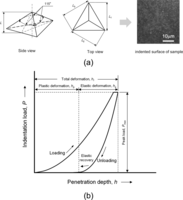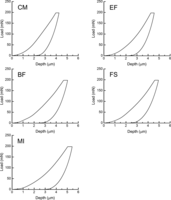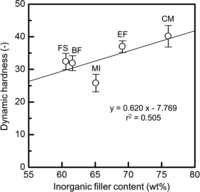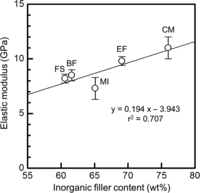Mechanical evaluation of five flowable resin composites by the dynamic micro-indentation method
- 1Department of Operative Dentistry, School of Dentistry at Matsudo, Nihon University, Matsudo, Japan
- 2Department of Dental Biomaterials, School of Dentistry at Matsudo, Nihon University, Matsudo, Japan
- Yasuhiro Tanimoto, Department of Dental Biomaterials, School of Dentistry at Matsudo, Nihon University, 2-870-1 Sakaecho Nishi, Matsudo, Chiba 271-8587, Japan. Email: tanimoto.yasuhiro{at}nihon-u.ac.jp
Abstract
Measurement of the strength of brittle materials, such as resin composites, is extremely difficult. Micro-indentation hardness testing is a convenient way of investigating the mechanical properties of a small volume of material. In this study, the mechanical properties of five commercially available flowable resin composites were investigated by the dynamic micro-indentation method. Additionally, the effects of inorganic-filler content on the dynamic hardness and elastic modulus of flowable composites obtained by this method were investigated. The weight percentages of the inorganic fillers in the resin composites were determined by the ashing technique. The results indicate that the mechanical properties of flowable composites are affected by not only the filler content but also the properties of the resin matrix. In conclusion, the dynamic micro-indentation method is a useful technique for determining the mechanical behavior of dental resin composites as brittle material.
- Flowable resin composites
- dynamic micro-indentation method
- inorganic-filler content
- dynamic hardness
- elastic modulus
Introduction
Dental resin composites are widely used as restorative materials because they are esthetically pleasing and relatively easy to handle in restorative treatment. For clinicians, the use of a composite with a specific consistency in restorative treatment is attractive because the viscosity affects the application and manipulation of the material. Flowable composites are characterized by low modulus of elasticity, low viscosity, and high wettability of the tooth structure.1,2 Accordingly, in clinical situations, flowable composites have been reported to adapt well to the cavity wall owing to their low viscosity.3,4 Furthermore, the strength of composites in the oral environment as well as the handling characteristics of composites in restorative procedures is important. Various strengths of flowable composites have been evaluated by different mechanical testing techniques.5⇓–7 For example, Tjandrawinata et al.8 evaluated the flexural properties of eight flowable light-cured restorative materials and compared them with two conventional restorative materials. They reported that the modulus of resilience value of the flowable composites was higher than that of the conventional composites. Similarly, Ilie and Hickel9 compared the mechanical properties, such as flexural strength, compressive strength, and diametral tensile strength, of 72 commercially available restorative composites including flowable composites. They reported that a good correlation was only found between the flexural strength and flexural modulus, which was also correlated with the filler volume, whereas compressive strength and diametral tensile strength were less sensitive. Strength is the maximum stress required to fracture a structure or material. It is called flexural strength, compressive strength, or diametral tensile strength depending on the predominant type of stress present. Generally, the high compressive strength of resin composites does not imply high tensile strength, reflecting the somewhat brittle nature of resin composites. Thus, the measurement of the tensile strength of brittle materials, such as resin composites, is extremely difficult.
To determine the mechanical properties, indentation hardness tests are the most commonly used non-destructive testing procedures in the metal industry and in research because they provide an easy, inexpensive, and reliable method to evaluate the basic properties of developed or new materials.10,11 The indentation hardness of materials is measured in several ways by forcing an indenter with a specific geometry, such as a ball, cone, or pyramid, into the specimen’s surface. In general, there are two methods used to measure the indentation hardness. The conventional procedure for testing hardness consists of applying a fixed load on a diamond indenter and measuring, with the aid of optical microscopy, the dimensions of the resultant indentation on the surface of the test material after unloading. However, it is difficult to optically measure such dimensions with a high degree of accuracy for indents at the micro/nano-scale. On the other hand, the dynamic nano- or micro-indentation method has significant advantages over conventional hardness testing. In this depth-sensing indentation hardness test, a diamond indenter tip is pressed into the specimen until a given maximum load or depth and then removed. The load on and the displacement of the indenter are simultaneously recorded. This method can provide well-defined mechanical parameters of materials, such as the dynamic hardness and the elastic modulus.
In this study, we investigate the mechanical properties of five commercially available flowable resin composites using the dynamic micro-indentation method. The effects of inorganic-filler content on the dynamic hardness and elastic modulus of flowable composites obtained by this method are also investigated.
Materials and methods
Preparation of dental resin composites
Five commercially available flowable composites were prepared. Table 1 lists the flowable resin composites, manufacturer, composition, and other information. All materials were of shade A2. To fabricate the test specimens for the dynamic micro-indentation test, the flowable composite pastes were placed in a circular gum mold (5-mm diameter × 2-mm depth), which is described in detail elsewhere.12 The surface of the composite was covered with polyester strips (Striproll; KerrHawe, Bioggio, Switzerland). The molded composite was then pressed by a glass slide. As amply described by our previous study,12 visible light was irradiated to the surface using a laboratory light-curing unit (α-LIGHT II; J. Morita Tokyo MFG. Corp., Tokyo, Japan) for 90 s to ensure complete polymerization of the composite. After polymerization, the composite was carefully removed from the mold. Both surfaces of the composite were polished using #800 and #1000 silicon carbide paper under running water to remove residual monomers. Finally, the five flowable composites were stored in distilled water for 24 h at 37°C.
Flowable resin composites used in this study.
Dynamic micro-indentation test
Investigation of the mechanical behavior of the flowable composites was performed using a dynamic ultra-micro-hardness tester (DUH-211; Shimadzu Co., Kyoto, Japan) fitted with a Berkovich indenter tip (Figure 1(a)). The specimens were fixed onto an attached holder. Dynamic micro-indentation primarily involves applying a controlled load (P) through a diamond tip that is in contact with a smooth surface. The penetration depth (h) of indentation is continuously recorded as a function of load. Figure 1(b) shows a schematic illustration of the typical micro-indentation load–penetration depth curve obtained from dynamic micro-indentation tests. During indenter loading and unloading, the specimen is subjected to both plastic deformation (hp) and elastic deformation (he). The total deformation (ht) is the sum of hp and he in the micro-indentation load–penetration depth curve. Moreover, the dynamic hardness and elastic modulus can be obtained from the indentation load and penetration depth data.13
Dynamic ultra-micro-hardness testing system used in this study. (a) Schematic image of the geometry of the Berkovich indenter tip. Tip height (L) is defined as L = (1/3) (L1 + L2 + L3). The photograph is the indented surface of the sample after testing. (b) Schematic illustration of the micro-indentation load versus penetration depth curve obtained from the testing.
The dynamic hardness (DH) of the sample was calculated from the following equation

where α is a geometrical constant of the Berkovich indenter (3.8584), P is the applied load during the indentation test, and h is the penetration depth of indentation.
The elastic modulus (E) of the sample was calculated from the following equation

where Er is the reduced elastic modulus from the indenter, V is Poisson’s ratio for the sample, Vi is Poisson’s ratio for the Berkovich indenter (0.07), and Ei is the modulus of the Berkovich indenter (1140 GPa).
In this study, the dynamic micro-indentation test was carried out with peak loads (Pmax) of 196.1 mN. The load rate was kept constant at 13.32 mN/s, and the hold time at the maximum load was set to 15 s. The dynamic micro-indentation results, such as dynamic hardness and elastic modulus, were obtained as the average values of five specimens (n = 5), which were each measured five times.
Percentage weight of inorganic fillers
The percentage weight of the inorganic fillers of the composites was examined by the ashing technique. A porcelain crucible containing ~0.2 g of composite paste was sintered at a maximum temperature of 550°C under atmospheric pressure in a furnace (MSFT-1520-P; Nikkato Corp., Tokyo, Japan). The temperature was increased at a rate of 5°C/min to the maximum temperature, and the hold time was set to 2 h at 550°C. The weight percentages of the fillers were determined by calculating the difference in weight of the sample before and after sintering using a precision balance (AG285; Mettler-Toledo GmbH, Greifensee, Switzerland). Three samples of each composite were analyzed (n = 3).
Statistical analysis
The results obtained from the dynamic micro-indentation tests were examined with a one-way analysis of variance (ANOVA) and tested using Scheffé’s test for multiple comparisons of means at p = 0.01.
Results
Typical indentation load–penetration depth curves of the five flowable composites are shown in Figure 2. The indentation load–penetration depth curves for all composites indicated creep phenomenon of the specimen at peak load of 196.1 mN. Table 2 shows the total deformation (ht) values, which are the sum of plastic deformation (hp) and elastic deformation (he), of the five flowable composites. Here, indentation deformation, ht = hp + he, is always satisfied. The hp/ht and he/ht ratios are also listed. MI showed significantly larger ht and hp values than the other composites (p < 0.01). MI also had the highest hp/ht ratio of the five composites. Table 3 summarizes the dynamic hardnesses and elastic moduli of the five resin composites as well as the weight percentages of inorganic filler. The dynamic hardnesses of the composites ranged from 25.8 to 40.2 and increased in the order MI < BF < FS < EF < CM. The elastic moduli of the composites ranged from 7.4 to 11.0 GPa and increased in the order MI < FS < BF < EF < CM. That is, CM exhibited both the highest dynamic hardness and the highest elastic modulus of the five composites. For all the composites, the inorganic-filler contents obtained from the experiments were less than the filler contents given by the manufacturers. The differences between the inorganic-filler contents obtained from the experiments and the filler contents given by the manufacturers for CM, EF, BF, FS, and MI were 5.0, 1.9, 5.2, 17.9, and 3.9 wt%, respectively. For FS, a large difference was found in the filler content between our experimental data and the data given by the manufacturers (17.9 wt%). Figure 3 shows the relationship between the dynamic hardness and inorganic-filler content. There was no correlation between the dynamic hardness and inorganic-filler content (y = 0.620 x − 7.769, r2 = 0.505). Figure 4 shows the relationship between the elastic modulus and inorganic-filler content. There was a weak correlation between the elastic modulus and inorganic-filler content (y = 0.194 x − 3.943, r2 = 0.707).
Typical indentation load–penetration depth curves of five flowable resin composites obtained from dynamic ultra-micro-hardness tests.
Total, plastic, and elastic deformations of the five flowable resin composites.
Dynamic hardnesses and elastic moduli of the flowable resin composites.
Relationship between the dynamic hardness and inorganic-filler content for the five flowable resin composites. The 95% confidence intervals of CM, EF, BF, FS, and MI were 37.2–43.1, 35.4–38.5, 29.9–33.9, 30.2–34.6, and 23.5–28.2, respectively.
Discussion
It is important for clinicians to have reliable information on the mechanical properties of commercially available resin composites, as well as the handling characteristics in restorative procedures. Micro-indentation is a depth-sensing technique that can accurately characterize the mechanical properties of almost all types of solid materials at a small scale. In particular, this method can continuously record the penetration depth of the specimen during dynamic loading and unloading at the indentation tip while providing information on the degree of plastic and elastic deformation, and the hardness and elastic modulus of the materials. Therefore, knowledge of the mechanical properties of such flowable composites provided by micro-indentation is very helpful for clinicians in relation to restorative treatment. In this study, the micro-indentation method was used to investigate the mechanical properties, such as dynamic hardness and elastic modulus, of five commercially available flowable composites.
In general, composites need a high percentage of inorganic-filler particles to withstand high mechanical stresses. Thus, determination of the inorganic-filler content of commercial composites is very important because it directly affects the mechanical properties of the composites. The weight percentages of the inorganic fillers were determined using the ashing technique. The ashing technique destroys the organic part of the composite and measures only the real weight of the inorganic fillers.12 For CM, EF, BF, and MI, the inorganic-filler contents obtained from the experiments were similar to the filler contents given by the manufacturers. In other words, small differences (approximately <5 wt%) were found between our experimental data and the composition given by the manufacturers. Dental composites are normally composed of a dispersion of silica filler within a resin matrix. To enhance the chemical bonding between the silica glass and dimethacrylate, the silica glass is treated with a silane coupling agent, which has a methacryloyl group at its terminal end. Sabbagh et al.14 reported that some manufacturers assess the weight percentage of fillers before the silanization of the fillers, whereas others include the percentage of silane coating in their calculations. As a result, it is thought that the differences between experimental filler content and those given by manufacturers can be attributed to filler silanization.15 These findings for the inorganic-filler content agree with our previous study.12 On the other hand, for FS, the inorganic-filler contents obtained from experiments were considerably less (~18 wt%) than the filler content given by the manufacturers. By considering recent advances in nanotechnology, nanofill composites such as Filtek Supreme (FS) contain silica and zirconia nanoparticles, which are partially calcined to produce micron-sized porous clusters that are infiltrated with silane prior to incorporation into a resin matrix.16⇓–18 Therefore, it is expected that there is more silane coupling agent contained in FS than the other composites because the surface area of the filler particles increases with decreasing particle size of the filler.19
Although the filler content generally affects the mechanical properties of composites, there was no correlation between either dynamic hardness or elastic modulus and the inorganic-filler content of the flowable composites considered in this study (Figures 3 and 4). However, except for MI, there was a strong correlation between both dynamic hardness (y = 0.545x − 1.021, r2 = 0.984) and elastic modulus (y = 0.179x − 2.563, r2 = 0.998) and the inorganic-filler content. These results may be because of the influence of the composition of the matrix resin. Bisphenol-A-glycidyl methacrylate (BisGMA), urethane dimethacrylate (UDMA), and triethylene glycol dimethacrylate are traditional dimethacrylates widely used as the resin component.20 Bonilla et al.6 investigated the fracture toughness of nine commercially available flowable resin composites. They reported that composite materials having UDMA as the major component of the resin matrix have lower fracture toughness than composites based on methacrylate or BisGMA. For the five commercially available flowable composites used in this study, MI is based on UDMA as the major component of the resin matrix, in contrast to other composites (see Table 1). In addition, it was apparent that MI has higher hp/ht ratios, representing a higher degree of plastic behavior, compared with composites based on BisGMA. From the results obtained in this study, flowable composites have a large resin matrix component, indicating that the mechanical properties of flowable composites are dependent not only on the filler content but also on the properties of the resin matrix. The matrix properties, such as composition and viscosity, affect both the dynamic hardness and elastic modulus, and will be further investigated in our next series of experiments.
Finally, it is well known that the mechanical properties of composites depend on stress transmission at the interphase between the silica filler and the resin matrix in the composites. Thus, optimization of the mechanical properties of composites is based on knowledge of the relationship between the microstructure and the macroscopic response. Finite element analysis (FEA) has the potential to predict the mechanical behavior of dental composites, which can be microscopically divided into the filler, the matrix, and the interphase.19,21 To analyze the mechanical characterization of composites by FEA, the material properties of the filler reinforcement, resin matrix, and interphase components are required. In particular, the elastic modulus is a basic input parameter for all of the components in computational FEA. Ho and Marcolongo22 evaluated the interfacial mechanics of bioactive composites composed of polymethylmethacrylate and hydroxyapatite for mandibular bone substitutes using the nano-indentation technique. They concluded that nano-indentation is a powerful technique for quantifying interfacial interactions in composites and is capable of showing more specific local differences in the interfacial mechanics than the quasi-static bulk properties, such as flexural bending. In this study, the main advantage of the dynamic micro-indentation test compared with other mechanical test procedures for resin composites is the relative simplicity of the experimental setup. The material properties of the components, such as the filler reinforcement, the resin matrix, and the interphase, will be further investigated by the dynamic micro-indentation method.
Conclusion
This study compares the mechanical behavior of five commercially available flowable resin composites by the dynamic micro-indentation method. The following conclusions were drawn:
-
The weight percentage of inorganic fillers was determined using the ashing technique. The inorganic-filler content obtained from experiments was less than the filler contents given by the manufacturers. It is thought that the differences between the experimental filler content and those given by manufacturers can be attributed to filler silanization.
-
Overall, when the inorganic-filler content increased, there was a remarkable increase in both the dynamic hardness and elastic modulus of the composites measured by the dynamic micro-indentation method. In addition, the mechanical properties of the flowable composites were affected not only by the filler content but also by the properties of the resin matrix because they have lower filler content than conventional composites.
-
In light of these results, the dynamic micro-indentation method is a useful technique for determining the mechanical properties of composites as brittle material within very small areas on the surface of the sample without complex sample preparation.
Article Notes
-
Declaration of conflicting interests The authors declare that there is no conflict of interest.
-
Funding This work was supported in part by a Grant-in-Aid for Scientific Research (C) (No. 23592813) from the Ministry of Education, Culture, Sports, Science and Technology of Japan.
- Received December 27, 2013.
- Accepted April 5, 2014.
- © The Author(s) 2014















